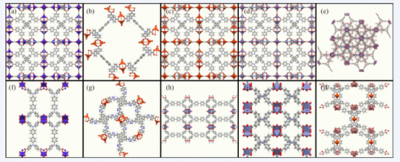Newswise — In a new study published on 15 July 2023, in the journal Frontiers of Environmental Science & Engineering, researchers from Sichuan University have unveiled significant insights into the structure-performance relationships of metal-organic frameworks (MOFs). Their study not only sheds light on the complexities involved in the iodine uptake capabilities of MOFs but also emphasizes the necessity for a comprehensive, multifaceted analysis.
In this comprehensive study, researchers employed large-scale molecular simulation and machine learning (ML) to identify the most effective MOFs for capturing gaseous iodine. Utilizing a grand canonical Monte Carlo simulation across a database of 8,862 MOFs, the team was able to predict iodine uptake values and pinpoint the top 10 MOFs, visualizing their specific adsorption sites. Further employing ML, they established vital structure-property relationships, linking MOFs' structural and chemical features to their iodine capture efficiency. This study not only revealed key insights into the MOFs' structure-performance relationships, demonstrating a strong correlation between certain geometric features like large cavity size and surface area and enhanced iodine uptake, but also highlighted the necessity of multifactorial analysis. This approach was crucial in understanding that no single feature could solely predict a MOF's iodine uptake capability, marking a significant advancement in the field of environmental material design.
Highlights
● Screened 8862 metal-organic frameworks for I2 capture via molecular simulation.
● Ranked metal-organic frameworks on predicted I 2 uptake and identified Top 10.
● Established quantitative structure-property relationships via machine learning.
This research establishes a comprehensive framework for creating advanced MOF adsorbents, enhancing the capture and recovery of radioactive iodine and similar volatile environmental hazards. It presents a significant stride in improving nuclear fuel reprocessing and management, substantially contributing to radiochemistry and the pursuit of sustainable nuclear energy.
###
References
DOI
Original Source URL
https://doi.org/10.1007/s11783-023-1748-3
Funding information
The National Natural Science Foundation of China (22176135).
The Fundamental Research Funds for the Central Universities in China (YJ201976).
Start-up funds from the School of Chemical Engineering, Sichuan University (C.L.).
About Frontiers of Environmental Science & Engineering
Frontiers of Environmental Science & Engineering (FESE) is the leading edge forum for peer-reviewed original submissions in English on all main branches of environmental disciplines. FESE welcomes original research papers, review articles, short communications, and views & comments. All the papers will be published within 6 months since they are submitted. The Editors-in-Chief are Academician Jiuhui Qu from Tsinghua University, and Prof. John C. Crittenden from Georgia Institute of Technology, USA. The journal has been indexed by almost all the authoritative databases such as SCI, Ei, INSPEC, SCOPUS, CSCD, etc.
Journal Link: Frontiers of Environmental Science & Engineering
MEDIA CONTACT
Register for reporter access to contact detailsArticle Multimedia

Credit: Frontiers of Environmental Science & Engineering
Caption: Graphic abstract.

Credit: Frontiers of Environmental Science & Engineering
Caption: Illustration of the proposed large-scale virtual screening strategy of MOFs for high performing iodine adsorbents.

Credit: Frontiers of Environmental Science & Engineering
Caption: Overview of the crystal structures of Top 10 MOFs identified with the highest predicted I2 uptake (a–e: Nos. 1–5; f–j: Nos. 6–10).


